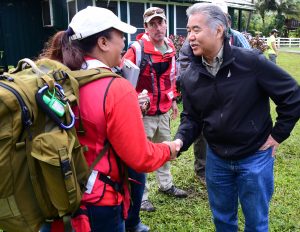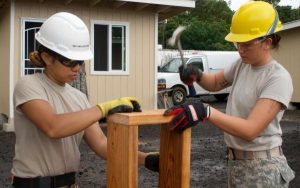Strong, steady and strategic. Whether it’s helping disaster victims recover or improving the lives of working families, Governor Ige has committed to delivering on the state’s most pressing challenges. This edition highlights the latest efforts for disaster relief, new laws to expand affordable housing, education, and environmental and consumer protection, the launch of major state projects, and the 150th anniversary of the Gannenmono, the first Japanese immigrants to Hawai‘i.

Gov. Ige thanks Renise Bayne and Pedraic Gallagher, Red Cross director of disaster services, for their help on Kaua’i.
Q. The past three months of dealing with floods and the volcano have tested your administration and the state’s resources. What types of help are on the way?
A. We know many people have been devastated by these events. The state is committed to helping residents rebuild their lives. We’ve been working closely with the Federal Emergency Management Agency (FEMA) as it sets up disaster assistance centers for federal, state and county services to help individuals qualify for aid. We’re making emergency loans available to farmers and have released millions of dollars to the counties of Kaua‘i, O‘ahu and Hawai‘i island for disaster-related repair of roads and public facilities. In the case of Kīlauea, even the FEMA people are saying this event is different because there’s no end in sight for the eruption.
Q. You’ve made many trips to the disaster sites on Kaua‘i and Hawai‘i island. Why was it so important to see everything firsthand?
A. It’s hard to imagine the devastation and destruction until you actually see it. We’ve talked about the rains on Kaua‘i being overwhelming and the lava swallowing homes, but you need to see the damage firsthand and talk with those who have suffered losses. That was critical in helping me understand the impact. I have to say, the community response has been heart-warming and inspiring, and the residents have been very appreciative of everyone’s support.

As the Kilauea eruption continues, the Hawai’i National Guard teamed with local organizations to build an emergency micro-shelter.
Q. What lessons have you learned as governor in responding to these natural disasters and in weighing policy issues that affect the whole state?
A. It boils down to understanding the authority you have and focusing on keeping the community safe. All of the decisions are focused on taking action. In a natural disaster with so many people involved and a real sense of urgency, you have to exercise your best judgment. In the case of the Puna Geothermal facility near the eruption, it was about choosing the best option, with advice from our team of experts, to quench the wells, move the pentane, and keep the community safe. When it comes to policy decisions, it starts with building a state budget that responds to the greatest needs, such as housing and homelessness, health and safety.
Q. You’ve signed several bills into law that support your priorities for working families. How would you assess the progress so far?
A. We’ve made tremendous progress in creating systems that work, such as building more affordable housing and helping to create successful homeless “navigation centers” such as Hale Mauliola on Sand Island. Everybody needs to work together — public and private — to leverage each other’s best assets and invest in programs that produce results. We’ve also focused on expanding programs like Early College, Hawai‘i’s Promise and job training in quality job areas such as health care, information tech and cybersecurity as well as making highway commutes easier for working families.